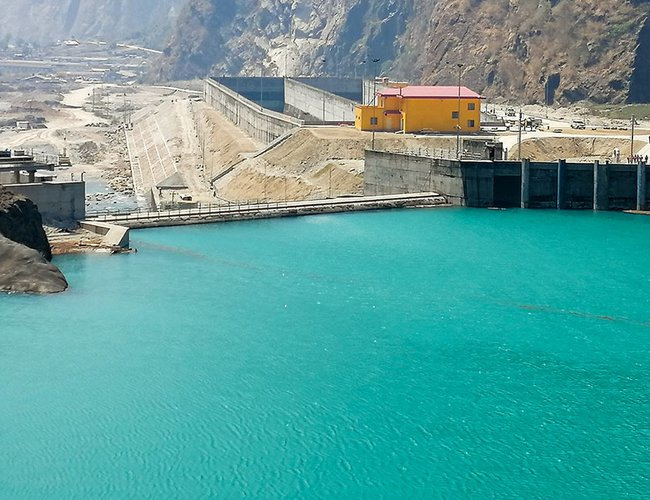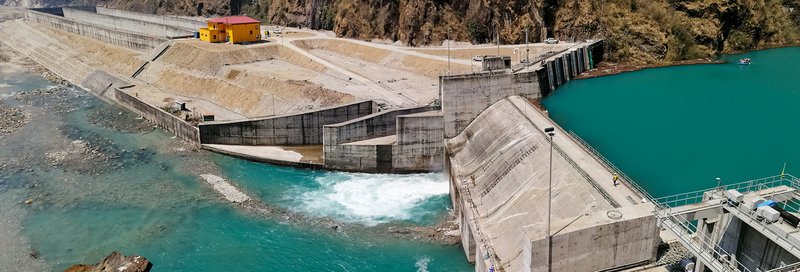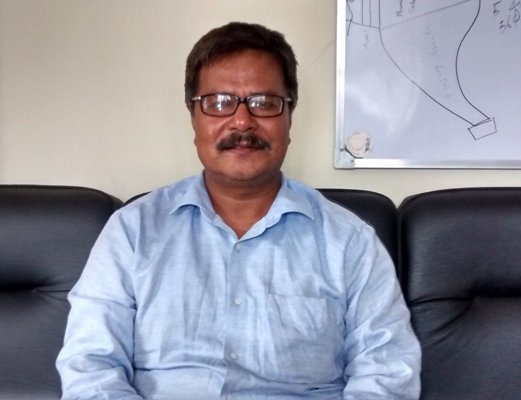
As it was projected a long time back, the Upper Tamakoshi Hydropower Project has proved that it could benefit the country and its shareholders in the short term and long term.
Just a year after the beginning of generation, the 14th AGM of the UTHL has approved issuing 1:1 (100 percent) on its current paid-up capital. As per the 257th meeting of the board of directors held on Ashad 30, 2079 which decided to submit a proposal for the issuance of right shares in the ratio of 1:1 (100%) on its current paid-up capital, the 14th AGM of the company approved it.
Located east of Kathmandu, the Upper Tamakoshi Project is being built using domestic financial resources. The national pride project was originally scheduled to be completed in mid-July 2016, but the earthquakes, Indian trade blockade and various technical and social issues pushed back the completion date.
As the 14th Annual General Meeting (AGM) was held in Kathmandu last month, which passed the proposal to issue 100 percent rights shares of the company.
The AGM approved a special proposal for capital increase through rights shares based on the report received from the sub-committee after analyzing the overall financials of the company.
The company plans to issue the right shares as the ratio of debt and capital could not be maintained due to various circumstances beyond control including the extension of the construction period.
After the issue of the right share, the paid-up capital will reach 21.18 billion rupees. At present, the share price of Upper Tamakoshi is less than Rs 500. UPPER’s 105.9 million shares have been listed in NEPSE.
Financing and organization
Established in March 2007, Upper Tamakoshi Hydropower Limited is an executing agency for the implementation of the Project, the majority share (51%) of the Company is held by four public entities, namely, Nepal Electricity Authority (NEA), Nepal Telecom (NTC), Citizen Investment Trust (CIT) and Rashtriya Beema Sansthan (RBS). NEA has a 41% stake, NTC has 6% and CIT & RBS each have a 2% stake in the Company.
Similarly, the general public and residents of Dolakha District will have 15% and 10% share respectively. The remaining 24% share is taken by contributors to Employees Provident Fund (EPF), NEA &Companies staff and staff of financial institutions providing loans.
Construction began in February 2011, and the project was originally slated for completion in July 2016. However, it has completed on August 2021 after several pushes back in its completion schedule. On 5 July 2021, the project was inaugurated by prime minister KP Sharma Oli.

Although it has faced several natural and man-made obstructions like earthquakes, COVID-19, and Nepal-India border disruptions, the delay from Lot 2 Hydro-mechanical Contractor, Upper Tamakoshi Hydropower Project (UTKHEP), which has started a commercial generation of electricity last August, has proved as a game-changer project in Nepal’s electricity generation.
After the sustained production from the project, Nepal’s energy status has changed from net importer to exporter. Generating cheaper electricity, the project also helped to reduce electricity tariffs and increase the profit of NEA. However, the main challenges before the project, which has been providing many benefits to promoters and lenders and consumers, how to offer benefits to public shareholders and turn the project into a profit-making venture
For the fourth consecutive quarterly financial disclosure, Upper Tamakoshi Hydropower Limited (UTKHPL) has generated income. According to the unaudited 4th quarter Statement of Financial Position, the company has submitted Rs.7 billion bills.
Despite its high potential to generate revenue, the company is yet to increase its income. To turn the company into a profit, the company is taking several initiatives including negotiations with financial institutions to revise the interest rates and reforms in other financial management, and equity adjustments in assets. The company is also working to capitalize on various structures of its asset.
To expand income, UTKHPL has decided on a second expansion stage, the 20-MW Rolwaling Khola Hydroelectric Project (RKHEP), which would contribute another 105 GWh of energy and enhance 210 GWh dry season energy from existing UTKHEP. After the completion of the process, the financial position will change in a better way.
Share Of Company
Although the project is one of the best projects so far in terms of energy generation, the share prices of the company are yet to reflect it. In the one-year period, the price of the share has fluctuated from Rs.781 to Rs. 535 now.
Inaugurated in July by then PM KP Sharma Oli, UTKHPL started the commercial operation date (COD) on 20 August with 4 units and full-fledged production with all 6 units from September 10, 2021.
Along with the construction of Rolwlaling HEP to increase capacity and income, the company has also been working to tighten internal expenditures aiming to reduce unnecessary spending; it will give more benefits to the public shareholders in the coming days. “The management is seriously working on how to provide more benefits to the public shareholders,” said Bigyan Shrestha, CEO of UTKHPL.
As the project started commercial production from all units on September 10, the revenue generated by the project has shown that it will be expected to generate more than Rs.9 billion annually from this year.
The current share price of the UTKHPL indicates that there is growing confidence in the public regarding the future of the project. People are expecting more dividends in the process.
A Game Changer
After the completion of Upper Tamakosi, Nepal’s status in producing electricity changed. With a surplus of energy at hand, Nepal’s policymakers have started to talk about replacing the LPG gas with electric cooking, electric vehicles and finally export of electricity.
Although the project has been delayed for a few years, it started generating and supplying electricity to the country when a major global energy crisis hit the world skyrocketing the prices of Petroleum Products including LPG.
With these, the project has not only saved over 9 billion annually importing electricity from foreign countries but also opened a way to offer benefits to shareholders and confidence among Nepali technicians.
Involved in the project from inception in different positions along with the first CEO Mr. Mrigendra Bahadur Shrestha, who had completed all the preliminary works to commence construction, Chief Executive Officer of UTKHPL Bigyan Shrestha, who has led the competent team of NEA to complete the mammoth project, is now working to optimize the benefit to public shareholders and keep their faith on the project.

“We are now working on how to provide more benefits from the project to beneficiaries including the public shareholders,” said Shrestha. “We have completed the mammoth task of completing the project. We have also considered now starting another project like this.”
For CEO Shrestha who spends his long carrier with the project, the decision to issue 1:1 ratio right shares at the last leg of his carrier with the project was the happiest decision.
As the private sector cannot invest comfortably in projects like semi-reservoir or reservoir projects like Upper Tamakosi, the government of Nepal needs to take initiative to construct this kind of project, said Shrestha who spent a long time with the project.
“My sincere thanks go to all helping hands to serve consecutive 33+ years in Nepal Electricity Authority with the accomplishment of 456 MW Upper Tamakoshi Hydroelectric Project in this tenure,” said CEO Shrestha.
With its daily peaking reservoir, UTKHPL can generate energy at a full capacity of 456 MW at peak time even during the dry season when the electricity production from the run of the river projects declined drastically.
With a natural head of 822 m and six underground units, it produces up to 2,281 GWh of electricity annually. After Rolwaling HEP commissioning approximately 315 GWh will added at all to Upper. This renewable energy will improve living conditions and promote economic development in the country.
All six turbines and generators have been in full operation since September 2021. During the rainy season, the total electricity generation of Nepal will exceed what the population and the economy are consuming. The country can benefit in several ways from the surplus of electricity: Electricity costs will decrease, there are plans to supply consumers in need with electricity free of charge, and Nepal could export electricity.
The Upper Tamakosi plant, however, can generate electricity at full capacity for a minimum of four hours during the dry season and the commissioning of Rolwaling HEP will enhance this peaking capacity to six hours according to the project. This is a historic achievement. This makes Nepal a power surplus country capable of exporting electricity.
After the commissioning of Rolwaling HEP, the Company UPPER will be in a position to enhance its income by 2 billion annually. This means, a 2 billion annual income added by investing another 8.5 billion for its construction. Moreover, Rolwaling will rescue the financial health of UPPER Tamakoshi.
Given its production capacity, the Upper Tamakoshi Hydroelectric Project is of high economic importance to Nepal as it has not only made Nepal an energy surplus country. But it also contributes to the national gross domestic product. Besides those imports, it also cut the import of electricity from India in the dry season-saving billions.
According to the study, the project is expected to contribute around 1 percent to the GDP and also help boost industrial production. The completion of the project has shown that Nepal can collect the fragmented capital within the country and invest in projects like Upper Tamaoshi.
The completion of the project and the beginning of the generation, it has boosted the morale and confidence of the Nepalese people. The project has shown that Nepali can now develop these types of projects through their own resources and manpower.
On the one hand, the project is a milestone for a country like Nepal facing an infrastructure gap but it is also a reminder of how cost and time overruns impact the development aspirations
Faced with all kinds of disasters and pandemics, the national pride project was originally scheduled to be completed in mid-July 2016, but the 2015 earthquakes hit the project very hard. The access road leading to the project site was totally destroyed when the project completed 79 percent of the civil works.
The delay in the completion of the project in time has increased the total cost of the project due to increased interest and dollar exchange rate. However, the contribution made by the project in the last year to the country’s overall economy is unmatchable its cost. Generating over Rs. 7 billion in the period of ten months of commercial operation, the project has shown that the project has something to offer to its public shareholders.

By issuing 1:1 ratio right shares, the company has shown that it cares about its public shareholders and their interest. The decision also boosted the confidence of the public shareholders.
National Pride Project but Ordinary Treatment
Although the UPPER Tamakoshi has been declared a national pride project, it has been treated as an ordinary project not getting any kind of incentives. Unlike other projects which have 30 years license period, this meg project’s license period is just 25 years. Increasing the five years additional will enhance the profits of the project
As the project passed through many unavoidable major natural disasters like an earthquake of 2015, border disruptions and COVID-19, which contributed to delaying the completion of the project, it does not get any time Extention for this loss period.
According to the company, it is making efforts to extend the license period by five years. This will enhance the overall profit of the company.
This is a national pride project but it does not get any privilege or incentive from NEA and the government. The period of the license is short as it is unable to provide adequate profit to investors. With the extension of five years license period, the financial health of UPPER will improve making.
- FOREIGN EXCHANGE: Largest Deposit
- Jul 22, 2024
- IMF: Approval Of SDR
- Jul 22, 2024
- NEPAL-KOREA RELATIONS: Fifty-Years Of Warm Relations
- May 31, 2024
- NEPAL-BRITAIN: Centenary Celebration
- May 31, 2024
- POLITCS: Forming New Alliances
- May 27, 2024
















